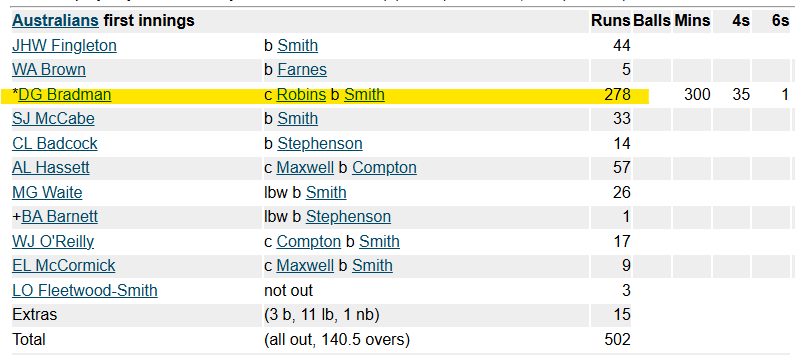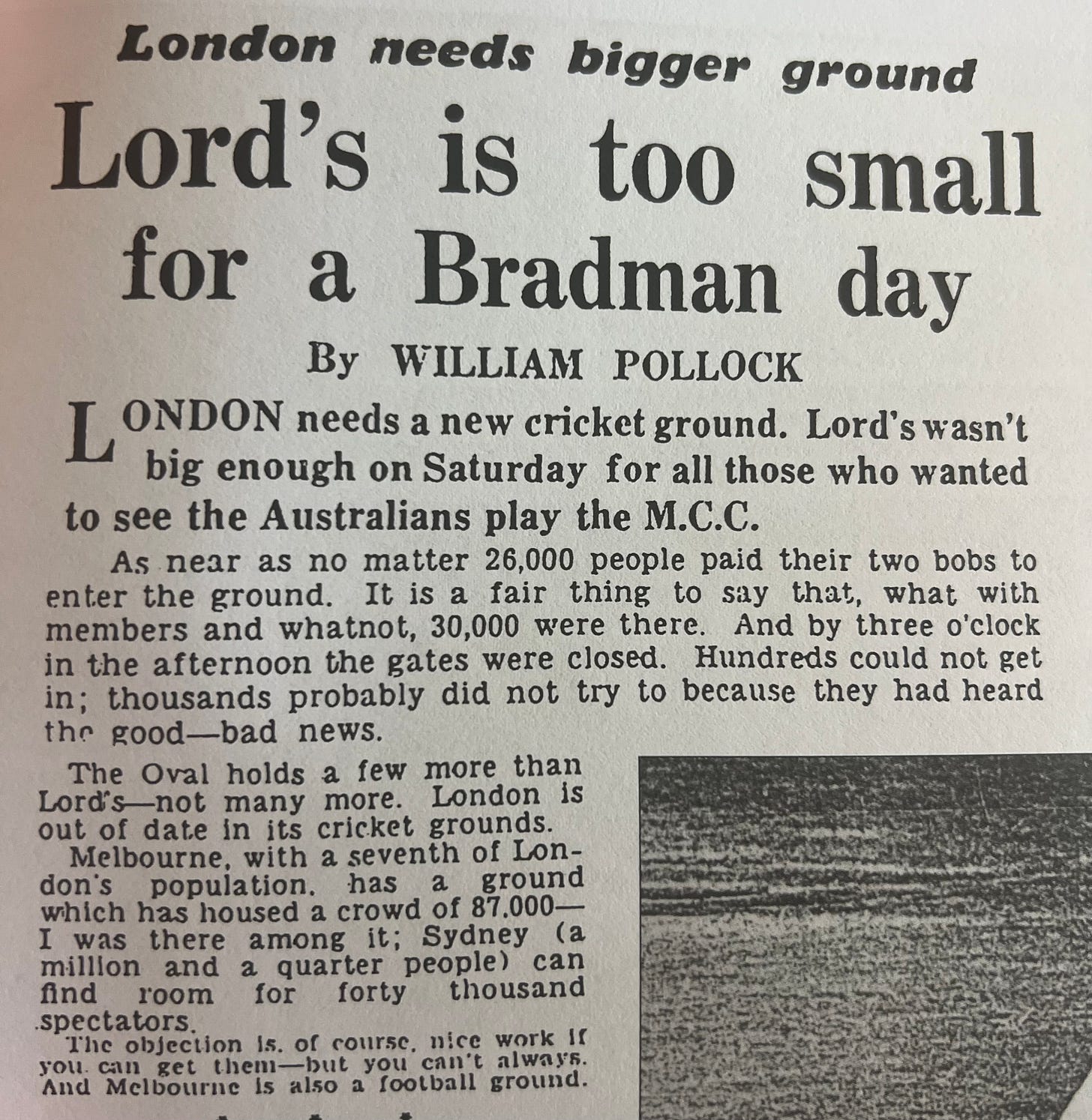Ball 1
Note: as you will see, the topic in Ball 1 has been evolving throughout 15 May. I am making this edit at 9pm, Sydney time, as it now appears as though Cricket South Africa will be insisting its Test players leave the IPL early, after all.
Well, that was quick.
When I began typing this on Thursday morning, it had been announced that Cricket South Africa (CSA) was standing up to the BCCI.
I must say, I was surprised . . . and impressed with their courage.
CSA had reportedly told the BCCI that it would not be allowing its Test players to stay in the IPL until the new date of the tournament’s conclusion - 3 June. Instead, its Test players would be required to leave after 25 May (the original date of the IPL final) - to prepare for the World Test Championship (WTC) final against Australia, starting at Lord’s on 11 June.
Here is what I had planned to write:
It is a bold decision and I admire it.
I hope the decision does not come back to bite them though. The BCCI has a long memory and individual players might not be too happy either - it could be a factor in whether they decide to sign future contracts with Cricket South Africa or not.
I needn’t have bothered.
I am now writing this on Thursday evening and the news has just broken that CSA has caved in and will allow its players to stay in the IPL until the conclusion of the tournament.
I can’t say I am surprised.
Ball 2
Cricket Australia, of course, had caved in instantly and announced that Aussie players would be free to do as they pleased. Even though such players are contracted to Cricket Australia and Cricket Australia had only released them until 25 May, the Board would not stand in their way: if the players decided to prioritise a domestic T20 tournament over the biggest event in the Test cricket calendar, that would be fine.
Actually, despite the above paragraph, I don’t blame them - and I would have done the same had I been in charge.
Only five players from the Aussie 15-player WTC squad are in the IPL.
Of those, Pat Cummins and Travis Head play for Sunrisers Hyderabad - a side which cannot make the playoffs and whose final game is now scheduled for 25 May - the date the original final was set down for. So no change there.
That leaves Josh Hazlewood, Josh Inglis and Mitchell Starc. As of today, 15 May, reports indicate that Starc is unlikely to choose to return. And Hazlewood is under an injury cloud and also might not return.
Realistically, therefore, it might end up being only Josh Inglis - and at the moment, he is still back in Australia and might not return to India.
Even if he does go back, no doubt CA decided this was not a hill worth dying on: might as well let Inglis - who probably won’t be in the WTC starting 11 anyway - try to win the IPL with Punjab Kings and then fly out straight to London.
I do think it is disappointing though, what the BCCI has done.
The IPL was interrupted for 10 days. It is soon to restart and will finish nine days later than originally scheduled.
The only concession to the fact that the tournament is now running longer is the scheduling of one extra double header: hence it lasting an additional nine days rather than 10.
I think the BCCI should have scheduled daily double headers to squeeze in the remaining games and finish the tournament on or as close to 25 May as possible. No doubt they would laugh my naivety - because doing so would burn a lot of money in lost broadcast revenue.
But I think it would have been the right thing to do.
Dates of interest
7 May: Last unaffected game
8 May: Punjab Kings and Delhi Capitals - abandoned game (this will be replayed)
17 May: IPL to resume
20-25 May: playoffs (under original schedule)
29 May - 3 June: playoffs (under new schedule)
11-15 June: WTC final
Ball 3
Regular readers will know I’ve never been keen for Marcus Harris to be in the Test side.
Also, I have said how I think the potential upside of Sam Konstas is high.
However, right as things stand, if forced to pick a player for my life in the World Test Championship final I would choose Harris over Konstas.
Harris has scored 749 runs for Lancashire at 83.2. Konstas has not been playing since the Australian summer - a summer in which he scored his runs at 37.3. It’s true that Harris only averaged 32.8 in the Aussie summer himself - but his form in the County Championship has been so good, it tips the scales for me.
What irks me is that it might have tipped the scales for the selectors too. Yet because of their bizarre insistence of looking to the ‘future’ they were predisposed to choose Konstas.
I can never understand ‘picking for the future’ at the best of times. But doing so in the lead up to the grand final is even crazier than usual. This upcoming match is the future. It is the most important Test match Australia will play until they next make the final, which will be in two years at the earliest.
It’s akin to being willing to sacrifice a gold medal in the Olympics in the hope that this might lead to a gold medal at the next Olympics.
And even worse, the theory behind it is nonsense anyway. Will Sam Konstas’s hand-eye coordination be improved by playing at Lord’s? If he is good enough for Test cricket he will prove it in the coming months - if he is not, he won’t.
It’s that simple. Pick the squad as though your life depends on the result - not because pyschobabble tells you you need to ‘blood’ someone for a Test match half a year away.
Ball 4
Where does Virat Kohli rate in Indian Test history?
I can’t comment on players prior to the mid-80s, but on those I have seen, I place him fifth.
My top five (and their Test averages) are:
Tendulkar 53.8
Gavaskar 51.1
Dravid 52.6
Sehwag 49.4
Kohli 46.9
For much of his career, it felt as though Kohli was a potential challenger to Tendulkar but his drop in the last few years has put paid to that. It’s always hard to get agreement but I suspect that the top 3 - albeit in a variety of orders - are fairly uncontroversial.
Some might quibble with Sehwag being above Kohli; others might argue that Laxman (average 46.0) and/or Azharuddin (average 45.0) should be above him.
What do you think? Feel free to let me know in the comments!
Ball 5
It will be incredibly harsh if Scott Boland doesn’t make the eleven for the final, but that’s how it’s looking.
Australia’s fast bowling stocks are incredibly strong. Assuming no injuries and that the big three of Cummins, Starc and Hazlewood are chosen, I was wondering how many trios Australia could pick before the side would be significantly worse.
An ‘Australia A’ line up might well be Boland, Brendan Doggett and Michael Neser. This would be a very good attack.
An ‘Australia B’ side might be Fergus O’Neill, Jhye Richardson and Sean Abbott. This would also be very good.
An ‘Australia C’ side might be Xavier Bartlett, Lance Morris and Mark Steketee. Still good but the standard is now dropping.
And who am I missing? Well, a host of players actually - headed by one of my favourites, Joel Paris - the 32-year-old left-arm quick from WA who has taken 202 first class wickets in an injury-plagued career at the incredible average of 19.6! Not to mention an average of 21.2 with the bat to boot: if Paris was a New Zealander he might be just wrapping up a Test career now as New Zealand’s third greatest ever cricketer, after Hadlee and Williamson. (Apologies to any Kiwis reading this!)
As for other Aussie quicks, I have also not mentioned Nathan McAndrew, Jackson Bird, Harry Conway, Gabe Bell, Cameron Gannon, Riley Meredith, Will Sutherland, Wes Agar or Spencer Johnson. And doubtless I have forgotten a couple too!
Ball 6
14 May saw the 87th anniversary of one of Don Bradman’s most dominant - yet largely forgotten - performances.
It was not in a Test match - but it was effectively a Test in all but name. Back in those day, the Marylebone Cricket Club (MCC) was effectively a synonym for England, and MCC would play a tour match against the travelling Australians at Lord’s - by far the biggest match of the tour outside the Tests.
In 1938, Bradman, aged 29, was at his absolute peak. He mauled the English attacks in Test and county games all tour long, finishing with 2,429 runs at 115.7, including 13 centuries.
And on 14 May, against the MCC, Australia batted first and the crowds flocked to see Bradman - Lord’s had to shut the gates at 3pm, with an estimated 32,000 in attendance.
Bradman did not disappoint. Coming in with the score at 1/11 he finished the day 257 not out, with the score now at 5/428. In other words, while Bradman made 257, at the other end his teammates and extras combined for just 160. He was eventually out for 278.
It was Bradman’s eighth consecutive score of 50 or more and the 14th consecutive match in which he had reached 50 in at least one innings.
Sadly, as far as Test matches go he was to be cut short at his peak - he only batted in three more Test matches in the next eight and a half years: in the 1938 tour itself one Test was rained off entirely and in one he broke his ankle and did not bat (he scored centuries in the three Tests in which he did). No Tests were scheduled for the next summer in Australia (1938/39) and then of course the war began.
Bradman’s next two test innings after the war - by then aged 38 - were 187 and 234.






Thanks Paul, I love the Bradman stuff
Awesome, Paul🍻🏏